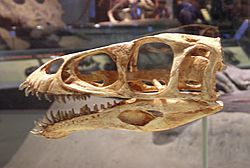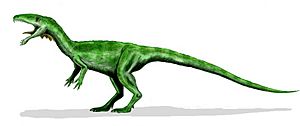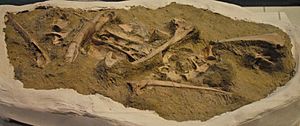Masiakasaurus facts for kids
Quick facts for kids MasiakasaurusTemporal range: Late Cretaceous
|
|
|---|---|
 |
|
| Masiakasaurus skull at the Field Museum of Natural History | |
| Scientific classification | |
| Kingdom: | |
| Phylum: | |
| Class: | |
| Superorder: | |
| Order: | |
| Suborder: | |
| Infraorder: | |
| Superfamily: | |
| Family: |
Noasauridae
|
| Genus: |
Masiakasaurus
|
| Binomial name | |
| Masiakasaurus knopfleri Sampson et al., 2001
|
|
Masiakasaurus was a small, meat-eating dinosaur that lived in Madagascar during the Late Cretaceous period. This theropod dinosaur walked on two legs and had a long neck and tail. It was known for its unusual forward-pointing teeth. Masiakasaurus was about the size of a very large dog.
The full name of this dinosaur is Masiakasaurus knopfleri. It was named after Mark Knopfler, a famous guitarist and singer from the rock band Dire Straits. The scientists who discovered this dinosaur were listening to Knopfler's music while they were digging up its bones!
Contents
What Did Masiakasaurus Look Like?
Masiakasaurus was a small dinosaur, growing to be about 1.8 to 2 metres (5.9 to 6.6 ft) (6 to 6.5 feet) long. That's roughly the length of a small car!
Its Unique Skull and Teeth
The most special thing about Masiakasaurus was its teeth. The front teeth in its lower jaw stuck out forward, almost horizontally. These teeth were long and spoon-shaped, with slightly hooked edges. They were not like the sharp, tearing teeth of most other meat-eating dinosaurs.
The teeth at the back of its jaw were different. They were flatter and curved, more like the teeth of other carnivorous dinosaurs. These back teeth had serrated (saw-like) edges, which would have been good for cutting meat. The skull of Masiakasaurus was long and low, unlike the deep skulls of some other related dinosaurs.
Bones and Body Structure
The neck of Masiakasaurus was fairly stiff and held almost straight. Many of its bones, especially in the neck and upper back, were hollow. This made them lighter, which is common in many dinosaurs.
Its shoulder blade and shoulder bone were fused together into one large bone. While some related dinosaurs had very tiny arms, Masiakasaurus had longer forelimbs. Its upper arm bone was slender, and its hand bones were quite short. Scientists think it had four fingers, with the middle two being the longest.
How Was Masiakasaurus Discovered?
The first bones of Masiakasaurus were found in the Maevarano Formation in northwestern Madagascar. This area is famous for its Late Cretaceous fossils. Scientists first described this dinosaur in the journal Nature in 2001.
When it was first found, about 40% of the skeleton was recovered. This included parts of the skull, its unique teeth, arm bones, leg bones, and several vertebrae (backbones). In 2011, even more bones were discovered. These new finds helped scientists learn much more about this amazing dinosaur. Now, about 65% of the Masiakasaurus skeleton is known!
Where Does Masiakasaurus Fit in the Dinosaur Family Tree?
Masiakasaurus belongs to a group of dinosaurs called Noasauridae. This family is part of a larger group called Abelisauroidea. Scientists use special diagrams called cladograms to show how different dinosaurs are related. Here's a simplified look at where Masiakasaurus fits:
| Abelisauroidea |
|
||||||||||||||||||||||||||||||||||||||||||
How Did Masiakasaurus Live?
Diet and Hunting
The strange front teeth of Masiakasaurus were probably used for grabbing small prey. They wouldn't have been good for tearing apart large animals. The back teeth, however, were sharp and good for cutting and slicing.
Scientists think Masiakasaurus might have eaten small animals like vertebrates (animals with backbones), invertebrates (like insects), and maybe even fruits. Its unique teeth suggest it had a very specific way of finding and eating food.
Growth and Development
Scientists have studied many Masiakasaurus fossils from different ages. They found that this dinosaur grew to its full size, which was about the size of a large dog, in 8 to 10 years. This growth rate was slower than other similar-sized meat-eating dinosaurs.
This slower growth might have been an advantage for Masiakasaurus. It lived in a tough environment with changing seasons. Growing slowly could have helped it save energy and nutrients.
Images for kids
-
Reconstructed skull, Field Museum of Natural History
See also
 In Spanish: Masiakasaurus knopfleri para niños
In Spanish: Masiakasaurus knopfleri para niños






